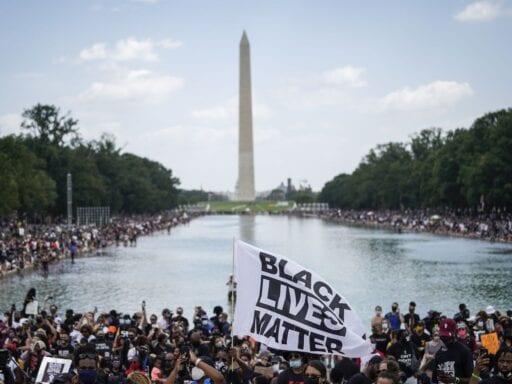Thousands of protesters marched on Washington against police violence.
Fifty-seven years after Martin Luther King Jr. spoke at the 1963 March on Washington, thousands of protesters for racial justice again gathered on the National Mall in Washington, DC. It was an emotional day of protesting against police violence, the culmination of a summer of nationwide protests in the wake of George Floyd’s death.
/cdn.vox-cdn.com/uploads/chorus_asset/file/21826611/GettyImages_1228243389.jpg) Jonathan Ernst-Pool/Getty Images
Jonathan Ernst-Pool/Getty ImagesRev. Al Sharpton, who first announced the “Get Your Knee Off Our Necks” March at Floyd’s funeral in June, spoke from the steps of the Lincoln Memorial, alongside the families of Black people who have been killed by police in recent memory.
“For too long, you acted like we didn’t matter,” Sharpton told the crowd. “They say, ‘Well, everybody matters.’ But everybody hasn’t mattered the same in America. The reason we had and we still have to say ‘Black Lives Matter’ is because we get less health care, like we don’t matter. We go to jail longer for the same crimes, like we don’t matter . . . Black lives matter, and we won’t stop until it matters to everybody.”
Floyd’s sister, Bridgett Floyd also addressed march-goers, asking them to carry on the legacy her brother created in death. “My brother cannot be a voice today,” Floyd said. “We have to be that voice, we have to be that change.”
/cdn.vox-cdn.com/uploads/chorus_asset/file/21826634/GettyImages_1228243262.jpg) Jonathan Ernst-Pool/Getty Images
Jonathan Ernst-Pool/Getty Images/cdn.vox-cdn.com/uploads/chorus_asset/file/21826596/GettyImages_1269381556.jpg) Michael M. Santiago/Getty Images
Michael M. Santiago/Getty ImagesThe march was planned before 29-year-old Jacob Blake was shot seven times in the back by police in Kenosha, Wisconsin, triggering another round of mass protests. Blake’s father, Jacob Blake, Sr. told the Washington crowd that they were holding court over racism in America, pronouncing it “guilty, guilty, guilty.” Other speakers drove home the need to vote this November.
Breanna Taylor’s mother, Tamika Palmer, thanked those who are working towards justice for her daughter’s death after being shot by Louisville, Kentucky, police in a no-knock raid. “What we need is change,” Palmer said. “And we are at a point where we can get that change, but we have to stand together, we have to vote.”
/cdn.vox-cdn.com/uploads/chorus_asset/file/21826684/GettyImages_1228247086.jpg) Jacquelyn Martin-Pool/Getty Images
Jacquelyn Martin-Pool/Getty ImagesOrganizers took care to prevent spread of Covid-19, mandating that attendees wear a mask and doing temperature checks for anyone entering the protest area around the National Mall.
/cdn.vox-cdn.com/uploads/chorus_asset/file/21826595/1269410046.jpg.jpg) Natasha Moustache/Getty Images
Natasha Moustache/Getty ImagesBut the urgency of the moment pulled such a massive crowd that thousands of protesters filled the area outside the temperature checks, and it became harder to socially distance within the protest area itself as the afternoon progressed.
/cdn.vox-cdn.com/uploads/chorus_asset/file/21826619/GettyImages_1269440932.jpg) Natasha Moustache/Getty Images
Natasha Moustache/Getty Images/cdn.vox-cdn.com/uploads/chorus_asset/file/21826670/GettyImages_1228243632.jpg) Jonathan Ernst-Pool/Getty Images
Jonathan Ernst-Pool/Getty ImagesTemperatures in the 90s didn’t seem to deter the crowds either, with many protesters wading into the reflecting pool to help cool off.
/cdn.vox-cdn.com/uploads/chorus_asset/file/21826628/GettyImages_1228244169.jpg) Drew Angerer/Getty Images
Drew Angerer/Getty ImagesThe march sought to renew the legacy of Martin Luther King, Jr.’s iconic “I have a dream” speech from 1963, which he gave in front of 250,000 demonstrators. That march eventually led to the Civil Rights Act, a sweeping set of laws banning discrimination on the basis of race, religion, sex, and national origin across areas of public life, like housing, employment, and public accommodations.
Whether the 2020 version achieves substantial legislative change remains to be seen.
/cdn.vox-cdn.com/uploads/chorus_asset/file/21826646/GettyImages_1228244211.jpg) Drew Angerer/Getty Images
Drew Angerer/Getty Images/cdn.vox-cdn.com/uploads/chorus_asset/file/21826688/GettyImages_1269439440.jpg) Natasha Moustache/Getty Images
Natasha Moustache/Getty Images/cdn.vox-cdn.com/uploads/chorus_asset/file/21826697/GettyImages_1269356555.jpg) Chip Somodevilla/Getty Images
Chip Somodevilla/Getty Images/cdn.vox-cdn.com/uploads/chorus_asset/file/21826700/GettyImages_1269498236.jpg) Chip Somodevilla/Getty Images
Chip Somodevilla/Getty Images
Author: Katelyn Burns
Read More



